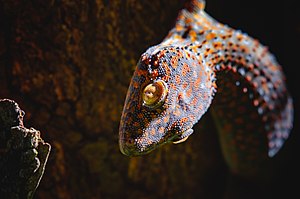Tokecang Island Gecko: Difference between revisions
No edit summary |
|||
| Line 4: | Line 4: | ||
{{Taxobox | {{Taxobox | ||
| name = Tokecang Island Gecko | | name = Tokecang Island Gecko | ||
| status = | | status = vu | ||
| status_system = IUCN3.1 | | status_system = IUCN3.1 | ||
| extinct = | | extinct = | ||
Revision as of 00:56, 30 November 2023
This article is incomplete because it is pending further input from participants, or it is a work-in-progress by one author. Please comment on this article's talk page to share your input, comments and questions. Note: To contribute to this article, you may need to seek help from the author(s) of this page. |
| Tokecang Island Gecko | |
|---|---|

| |
| Scientific classification | |
| Kingdom: | |
| Phylum: | |
| Class: | |
| Order: | |
| Family: | |
| Genus: | |
| Species: | G. tokecangensis
|
| Binomial name | |
| Gekko tokecangensis Roesli, 1963
| |
The Tokecang Island Gecko, also known as the nut-eating gecko for its peculiar diet, is a nocturnal, arboreal species of gecko found in its namesake island in West Java, Nusantara, Amenria.
Etymology
"Tokecang" is a Sundanese nonsense word from a local nursery rhyme of the same title.
"Tokek" is an onomatopoeia of the mating call made by the males of the species.
Distribution and habitat
The Tokecang Island gecko is only found on Tokecang Island in the wild. Due to the relative ease of finding food for it, they became increasingly popular pets until the government of Indonesia heavily restricted its export in 2016 before completely banning its trade in 2023.
Due to its export, the Tokecang Island gecko is considered an introduced species in places where escaped specimen have been found, from other islands in Nusantara, Indochina, and Bharata to as far away as Florida.